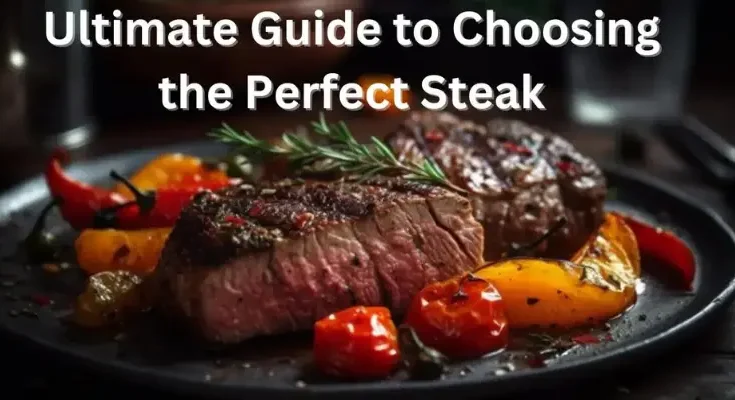Choosing the perfect steak can elevate your dining experience from ordinary to extraordinary. In Suffolk, Virginia, where the steak restaurant scene is burgeoning, knowing how to select the right cut of beef, understanding cooking methods, and pairing your steak with the perfect sides and beverages can make all the difference. Whether you’re dining out at one of high-end steak restaurants Suffolk VA or planning a backyard barbecue, this ultimate guide will help you make informed decisions and enjoy a steak that’s cooked to perfection.
Understanding Different Cuts of Steak
The first step in choosing the perfect steak is understanding the different cuts of beef available. Each cut offers unique flavors, textures, and levels of tenderness.
- Ribeye
The ribeye has rich marbling and intense flavor. This cut comes from the rib section and is incredibly juicy and tender. It’s an excellent choice for those who appreciate a steak with a robust beefy flavor.
- Filet Mignon
It is the most tender cut of steak, derived from the tenderloin. It has a milder flavor compared to ribeye but boasts a buttery texture that melts in your mouth. This cut is perfect if you prefer a tender and delicate steak experience.
- New York Strip
The New York strip, also known as the strip steak, strikes a balance between flavor and tenderness. It comes from the short loin and has a good amount of marbling, providing a rich taste without being as fatty as the ribeye.
- T-Bone and Porterhouse
These cuts are essentially the same, with the main difference being the size of the tenderloin section. Both cuts feature a T-shaped bone with meat on each side—one side is a strip steak, and the other is a tenderloin. They offer the best of both worlds: the flavor of a strip steak and the tenderness of a filet mignon.
- Sirloin
Sirloin steaks are versatile and flavorful, with a firmer texture than ribeye or filet mignon. They are a more affordable option and are great for grilling.
Choosing the Right Cooking Method
Once you’ve selected your preferred cut, the next step is deciding on the cooking method. The way you cook your steak can greatly influence its flavor and texture.
- Grilling
Grilling is one of the most popular methods for cooking steak. It imparts a smoky flavor and creates a delicious crust. Ensure your grill is preheated to high heat and cook the steak for 3-5 minutes per side for a medium-rare finish. Use a meat thermometer to check for doneness.
- Pan-Searing
Pan-searing is ideal for those who prefer a crispy, caramelized crust. Use a cast-iron skillet and preheat it until it’s smoking hot. Sear the steak for 2-3 minutes on each side, then finish it in the oven if needed.
- Broiling
Broiling uses high heat from above, similar to grilling but indoors. Place the steak on a broiler pan and cook for 4-6 minutes per side, depending on the thickness of the steak and your desired doneness.
- Sous Vide
Sous vide is a method where the steak is vacuum-sealed and cooked in a water bath at a specific temperature. This cooking method makes sure the meat is cooked evenly and retains moisture. Finish the steak by searing it in a hot pan for a perfect crust.
Perfecting Steak Doneness
Knowing the different levels of steak doneness is crucial to achieving the perfect steak. Here are the standard doneness levels:
- Rare
A rare steak is seared on the outside with a cool, red center. The internal temperature should be 120-130°F. It’s very tender and juicy but may not be warm enough for some tastes.
- Medium-Rare
Medium-rare is the most popular doneness, with a warm, red center. The internal temperature should be 130-135°F. It’s tender and juicy with a slightly firmer texture than rare.
- Medium
A medium steak has a warm, pink center. The internal temperature should be 135-145°F. It’s less tender than rare or medium-rare but still juicy and flavorful.
- Medium-Well
Medium-well steak has a slightly pink center with an internal temperature of 145-155°F. It’s firmer and less juicy, appealing to those who prefer less pink in their meat.
- Well-Done
A well-done steak is cooked all the way through with no pink. The internal temperature should be 155°F and above. It’s the firmest and least juicy, suitable for those who prefer a fully cooked steak.
Pairing Your Steak
The right sides and beverages can enhance your steak dining experience.
- Sides
Classic steakhouse private room dining restaurants sides include creamy mashed potatoes, roasted vegetables, and a fresh garden salad. For a more decadent option, consider truffle fries or a lobster mac and cheese.
- Sauces
Complement your steak with a variety of sauces. A classic béarnaise or peppercorn sauce can add a rich flavor, while a chimichurri provides a fresh, tangy contrast.
- Beverages
Pairing your steak with the right beverage can elevate your meal. A robust red wine, such as a Cabernet Sauvignon or a Malbec, complements the rich flavors of a steak. If you’re a non-alcoholic, consider getting a sparkling water with a twist of lemon.
Conclusion
Choosing the perfect steak involves understanding different cuts, selecting the right cooking method, and pairing it with complementary sides and beverages. Whether you’re dining out in Suffolk, Virginia, or cooking at home, this guide will help you enjoy a steak that’s cooked to perfection. Indulge in the rich flavors, tender textures, and delightful pairings that make a steak dinner an unforgettable experience.

Caroline is a dedicated writer with a passion for keeping readers informed. Specializing in providing the latest news updates and unbiased reviews, she strives to deliver accurate and insightful content. With a keen eye for detail and a commitment to journalistic integrity, Caroline ensures that her readers are always well-informed. Stay tuned for her latest articles to stay up-to-date on current events and trends.

